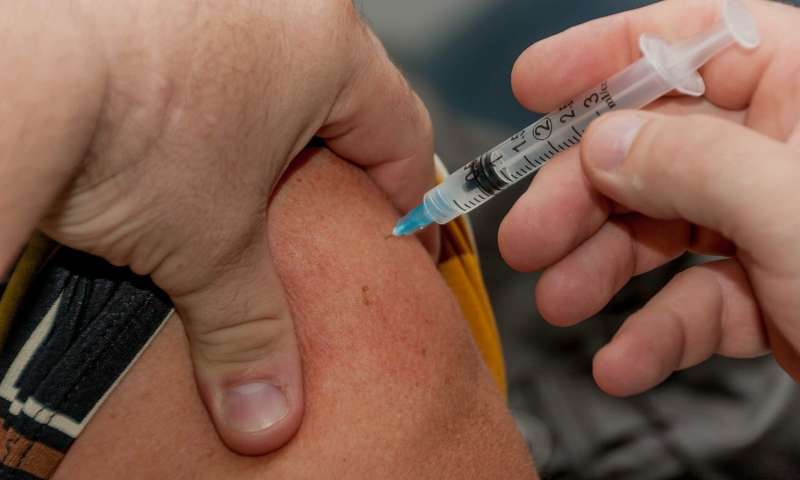
A study from Emory Vaccine Center provides insights into why the boost in immunity from seasonal flu vaccination lasts for months but not years, unlike some childhood vaccinations.
The home base for immune cells that produce antibodies is the bone marrow. Seasonal flu vaccination does increase the number of antibody-producing cells specific for flu in the bone marrow. However, most of the newly generated cells are lost within one year, Emory researchers found.
The findings are expected to inform the design of proposed longer-lasting “universal” flu vaccines, as well as ongoing vaccine studies against SARS-CoV-2. We need a flu shot every year partly because influenza viruses that infect humans mutate and swap genes with viruses from birds and pigs, but also because of the decline over time that this study highlights.
The results are scheduled for publication Thursday, August 13 in Science.
Most vaccine studies acquire samples of participants’ blood, which is where antibody-producing cells can be found for a few weeks after vaccination. Researchers led by Emory Vaccine Center director Rafi Ahmed, Ph.D. took the extra step of obtaining bone marrow samples—a more invasive procedure.
Most people already have some flu-specific plasma cells: the type of immune cells that secrete large amounts of antibodies. So the Emory researchers needed to distinguish between antibodies made by pre-existing cells and antibodies whose production was spurred by the strains present in the seasonal vaccine.
“We were able to follow the specific cells produced by the vaccine because they produced unique antibodies that can be identified using sequencing techniques,” says Carl Davis, Ph.D., first author of the paper and a postdoctoral fellow in Ahmed’s laboratory.
“We could see that these new antibodies expanded in the bone marrow one month after vaccination and then contracted after one year. On the other hand, antibodies against influenza that were in the bone marrow before the vaccine was given stayed at a constant level over one year.”
“What this shows is that just getting to the bone marrow is not enough,” Ahmed says. “A plasma cell has to find a niche within the bone marrow and establish itself there, and undergo gene expression and metabolism changes that promote longevity.”
The bone marrow collection was conducted from 2009-2018, in collaboration with Edmund K. Waller, MD, Ph.D., professor of hematology and medical oncology, medicine, and pathology at Emory University School of Medicine and Winship Cancer Institute.
In this study, 53 healthy volunteers agreed to provide bone marrow before seasonal flu vaccination and then one month after, with follow-ups for some about a year later. Vaccination increased the proportion of flu-specific cells (from an average of 0.8 percent to 1.9 percent) after a month. Yet the follow-up visit months later revealed that number had declined to baseline.
Looking for new vaccine-specific antibody-secreting cells required analyzing both the cells’ DNA and examining the antibodies they make, and then tracking those cells’ abundance in both blood and bone marrow. For most of the newly-generated plasma cell lineages, between 70 and 99 percent of the cells were lost after one year. Collaborators at Stanford University and at Cell Signaling contributed to this part of the project.
Some good news, especially for people participating in vaccine studies, is that the levels of antibody-secreting cells in blood correlate with long-term response in the bone marrow. So vaccine researchers can continue to monitor immune responses by looking for antibody-secreting cells in blood.
Also, vaccine additives called adjuvants could be expected to increase long-term bone marrow homing for antibody-secreting cells, Ahmed says. Standard inactivated flu vaccines do not contain adjuvants.
Source: Read Full Article